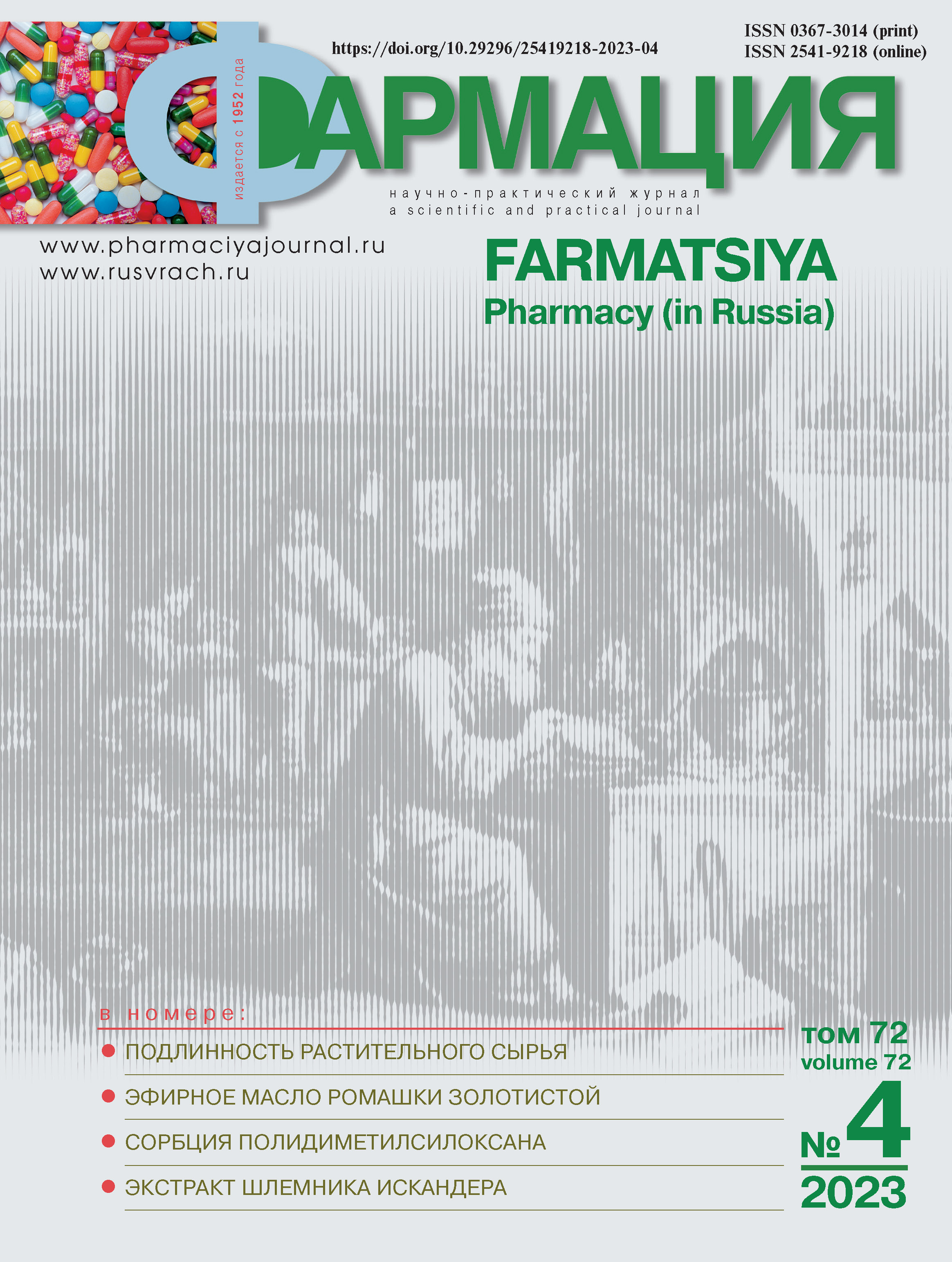Influence of sorption of polydimethylsiloxane on the determination of its content in tablet mixtures
- Authors: Obraztsova N.A.1, Samsonov A.A.1, Berezhnoy V.S.1, Shmeleva V.N.1, Golubeva N.A.1
-
Affiliations:
- JSC "Valenta Pharm"
- Issue: Vol 72, No 4 (2023)
- Pages: 50-57
- Section: Technology of medicines
- URL: https://journals.eco-vector.com/0367-3014/article/view/567944
- DOI: https://doi.org/10.29296/25419218-2023-04-07
- ID: 567944
Cite item
Abstract
Introduction. Excipients with sorption properties are used in pharmacy as carriers, glidants, stabilizers, thickeners. However, their use is limited by potentially incomplete desorption of active pharmaceutical ingredients (API), which can affect quantification of API. Accuracy of determining the content of polydimethylsiloxane (PDMS), which is main component of simethicone, is significantly depends on drug matrix.
Objective: to investigate sorption of PDMS in tablets containing simethicone and magaldrate. Evaluate the contribution of individual components of tablet mixture (TM) to degree of sorption.
Material and methods. TM of different composition were analyzed. The quantitative content of PDMS in TM was determined by gel permeation chromatography with refractometric detector.
Results. The different grades of magaldrate, probably differing in the ratio of amorphous and crystalline phases, exhibit different sorption activity to PDMS. The granulation of magaldrate with hypromelose reduce sorption of PDMS on the antacid. The most significant sorption of PDMS was observed in presence of silicon dioxide (SD). While complete desorption of PDMS did not occur. Direct relationship has been established between the amount of SD and the amount of sorbed PDMS.
Conclusion. We found that the main reason for decrease in degree of transition of PDMS into solution from simethicone and magaldrate TM is sorption of the polymer by antacid and SD. In case of magaldrate, we chose the conditions that allow complete desorption of polymer. While the similar structure of PDMS and SD, covalent and noncovalent interactions leads to partial chemisorption of PDMS and, consequently, its incomplete desorption.
Full Text
About the authors
Nadezhda Alexsandrovna Obraztsova
JSC "Valenta Pharm"
Author for correspondence.
Email: Nadezhda.Obraztsova@valentapharm.com
ORCID iD: 0000-0002-3239-9613
researcher, PhD in chemistry sciences
Russian Federation, Fabrichnaya Str., 2, Schelkovo, Moscow Region, 141108Aleksey Alexseevich Samsonov
JSC "Valenta Pharm"
Email: aleksey.samsonov@valentapharm.com
ORCID iD: 0000-0002-3557-3824
chief researcher
Russian Federation, Fabrichnaya Str., 2, Schelkovo, Moscow Region, 141108Valentin Sergeevich Berezhnoy
JSC "Valenta Pharm"
Email: Valentin.Berezhnoy@valentapharm.com
ORCID iD: 0000-0003-4086-0120
junior researcher
Russian Federation, Fabrichnaya Str., 2, Schelkovo, Moscow Region, 141108Varvara Nicolaevna Shmeleva
JSC "Valenta Pharm"
Email: Varvara.Shmeleva@valentapharm.com
ORCID iD: 0000-0001-6973-0405
head of research and development
Russian Federation, Fabrichnaya Str., 2, Schelkovo, Moscow Region, 141108Natalia Alexsandrovna Golubeva
JSC "Valenta Pharm"
Email: natalia.golubeva@valentapharm.com
ORCID iD: 0000-0002-4065-8494
R&D director
Russian Federation, Fabrichnaya Str., 2, Schelkovo, Moscow Region, 141108References
- Гуленков А.С., Мизина П.Г. Cорбция и десорбция жидкого растительного экстракта. Фармация. 2019; 68 (4): 27–31. [Gulenkov A.S., Mizina P.G. Sorption and desorption of liquid plant extract. Farmatsiya (Pharmacy), 2019; 68 (4): 27–31. doi: 10.29296/25419218-2019-04-04 (in Russian)].
- Van Eerdenbrugh B., Van Speybroeck M., Mols R., Houthoofd K., Martens J. A., Froyen L., Van den Mooter G. Itraconazole/TPGS/Aerosil®200 solid dispersions: characterization, physical stability and in vivo performance. Eur. J. Pharm. Sci. 2009; 38 (3): 270–8. doi: 10.1016/j.ejps.2009.08.002.
- Li X., Peng H., Tian B., Gou J., Yao Q., Tao X., Cai C. Preparation and characterization of azithromycin–Aerosil 200 solid dispersions with enhanced physical stability. Int. J. Pharm. 2015; 486 (1–2): 175–84. doi: 10.1016/j.ijpharm.2015.03.029.
- Maji I., Mahajan S., Sriram A., Medtiya P., Vasave R., Khatri D. K., .Singh P. K. Solid self-emulsifying drug delivery system: Superior mode for oral delivery of hydrophobic cargos. J. Control. Release. 2021; 337: 646–60. doi: 10.1016/j.jconrel.2021.08.013.
- McCarthy C. A., Ahern R. J., Devine K. J., Crean A. M. Role of drug adsorption onto the silica surface in drug release from mesoporous silica systems. Mol. Pharm. 2018; 15 (1): 141–9. doi: 10.1021/acs.molpharmaceut.7b00778.
- Richards R. M. E., Xing J. Z., Mackay K. Excipient interaction with cetylpyridinium chloride activity in tablet based lozenges. Pharm. Res. 1996; 13: 1258–64. doi: 10.1023/A:1016084824877.
- Torrado G., Garcıa-Arieta A., Rıos F., Menendez J. C., Torrado S. Quantitative determination of dimethicone in commercial tablets and capsules by Fourier transform infrared spectroscopy and antifoaming activity test. J. Pharm. Biomed. Anal. 1999; 19 (3–4): 285–92. doi: 10.1016/S0731-7085 (98)00116-2.
- Mojsiewicz-Pienkowska K. Size exclusion chromatography with evaporative light scattering detection as a method for speciation analysis of polydimethylsiloxanes. III. Identification and determination of dimeticone and simeticone in pharmaceutical formulations. J. Pharm. Biomed. Anal. 2012; 58: 200–7. doi: 10.1016/j.jpba.2011.09.003.
- Moore D.E., Liu T.X., Miao W.G., Edwards A., Elliss R. A RP-LC method with evaporative light scattering detection for the assay of simethicone in pharmaceutical formulations. J. Pharm. Biomed. Anal. 2002; 30 (2): 273–8. doi: 10.1016/S0731-7085(02)00321-7.
- Mojsiewicz-Pienkowska K. Size exclusion chromatography a useful technique for speciation analysis of polydimethylsiloxanes. Green Chromatographic Techniques: Separation and Purification of Organic and Inorganic Analytes. 2013; 1 (9): 181–202. doi: 10.1007/978-94-007-7735-4_9.
- Brecevic L., Bosan-Kilibarda I., Strajnar F. Mechanism of antifoaming action of simethicone. J. Appl. Toxicol. 1994; 14 (3): 207–11. doi: 10.1002/jat.2550140311.
- Громова О.А., Торшин И. Ю., Максимов В. А. Особенность молекулярно-биологических механизмов антацида Антарейт: множественность лечебных эффектов. Consilium Medicum. 2018; 20 (8): 80–4. [Gromova O.A., Torshin I.Yu., Maksimov V.A. Characteristic property of molecular and biological mechanisms of Antareit antacid: multiplicity of therapeutic effects. Consilium Medicum. 2018; 20 (8): 80–4. doi: 10.26442/2075-1753_2018.8.80-84 (in Russian)].
- Buist G. J., Burton J. S., Elvidge J. A. An infrared study of the interaction between Aerosil-200 and polydimethylsiloxane (dimethicone-1000). J. Pharm. Pharmacol. 1973; 25 (11): 854–8. doi: 10.1111/j.2042-7158.1973.tb09962.x.
- Ross S., Nishioka G. Monolayer studies of silica/polydimethylsiloxane dispersions. J. Colloid Interface Sci. 1978; 65 (2): 216–24. doi: 10.1016/0021-9797 (78)90152-2.
- Адсорбция полимеров. Липатов Ю.С. Киев: Наукова думка. 1972; 196. [Adsorption of polymers. Lipatov Yu.S. Kyiv: Science thought. 1972; 196 (in Russian)].
- Ross S., Nguyen N. Interactions of poly (dimethylsiloxane) with Lewis bases. Langmuir. 1988; 4 (5): 1188–93. doi: 10.1021/la00083a024.
Supplementary files






